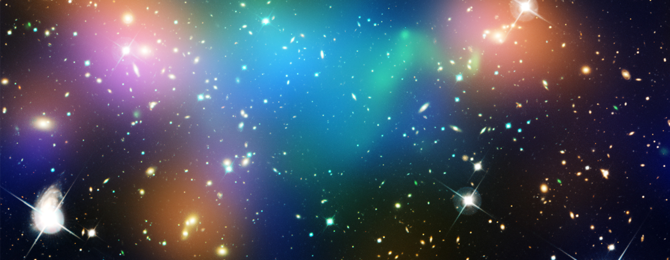.jpg?auto=compress%2Cformat&crop=faces&fit=crop&fm=jpg&h=360&q=70&w=540
)
Smithsonian Institute via Wikimedia
Is dark matter just made of "antimatter nuggets"?
New research asks how the world would look if chunks of antimatter collided with people, rocks, and stars
One of the biggest mysteries in physics today is dark matter. This is the name given to the 85% of matter in the galaxies whose existence can be inferred but which gives off no direct signs of any kind, including light. Dark matter is considered not to be “regular” matter, of the kind that makes up cats, smartphones, and stars. But this is pretty much all that can be said about it, so any advancement in our knowledge of what it could or couldn’t be is highly sought after.
On the other hand, antimatter, a staple of science fiction, conjures exotic images but is actually regular matter. It just has opposite electric charge that we usually think of matter having, and a few other sub-atomic qualities, which gives it the infamous property of exploding when it comes in contact with matter in our everyday world.
In a recent study, physicists wondered whether the mysterious dark matter could actually consist of plain old antimatter, because, well, there is nothing that would in principle prevent this. The researchers at Case Western Reserve University and Vanderbilt University followed a recent trend, asking whether dark matter can take the form of “nuggets” of particles bounded together and floating in interstellar space. They worked from existing data that they hoped would say something about the presence or absence of antimatter nuggets throughout the Milky Way and the universe at large.
But if these chunks of antimatter are found in the sky, couldn’t some of them fall to Earth as meteorites and hit people? The researchers thought of that.
Being struck by an antimatter lump would probably look like a gunshot that also gave you extreme radiation poisoning. Surely, something like that would result in out-of-the-ordinary injuries and deaths and find their way into the news. However no such mentions have appeared in Western media in at least the past ten years; this fact permitted the researchers to exclude, through statistical calculations, a range of the possible sizes and masses that the nuggets could have. With this rather low-tech method, they ruled out antimatter lumps between the sizes of a dust grain down to a cell, weighing anywhere from one gram up to a few hundred kilograms.
Nuggets of other combinations of size and mass were also excluded through the absence of other catastrophic observations out in space. Enormous antimatter nuggets in certain types of stars, for instance, would have caused “thermonuclear runaways," massive unexpected explosions, which have also not been observed.

Rendering of distribution of dark matter, galaxies, and hot gas in the core of the merging galaxy cluster Abell 520
NASA, ESA, CFHT, CXO, M.J. Jee (University of California, Davis), and A. Mahdavi (San Francisco State University)
Other, definitely more subtle, clues come from data related to the early ages of the universe. The presence of anti-nuggets would have caused the ratios of light elements in the cosmos to be different than what it is. It would have also left its mark in the spectrum of the most ancient light, a faint glow leftover from the Big Bang which bathes the sky and is one of the richest sources of information in cosmology. Neither of these extraordinary events has happened.
The absence of all these phenomena did not rule out anti-nuggets completely; more precisely, it did rule out anti-nuggets larger than a few kilometers per side, while it constrained the range of the mass that anything smaller could have. So the research is not completely finished.
Given the necessary constraints placed on them, if the nuggets actually exist, their constituent parts would have to be held together quite tightly, so that they would be more dense than atoms and perhaps even nuclei (the densest portions of the atom which are around 1010 times more dense than everyday matter). The researchers wouldn't want to exclude this possibility yet: according to Glenn Starkman, a physicist who co-authored the study, “We are going to have to look under every lamppost we can find, without prejudging whether it is likely to find the dark matter there."
In this spirit of expanding the search, he adds that his team is “now on the verge of launching a citizen science project on Zooniverse to allow the public to help us look at photos of granite slabs for ‘tenebrites’ — scars of the passage of dark matter through granite." In a similar manner to collisions in the human population, their tracks would be unique and visible. Plus, people can search for them in kitchen counter-top collections, where the slabs will be sampled.
As for the hits in humans, the idea was actually a byproduct of an earlier study which first described the possible use of granite slabs for finding tenebrites. “Soon after that paper, our colleague Bob Scherrer wrote to us to say, wouldn't these things kill people? Well, they might have! As far as we can tell there are billions of people who haven't been killed [in this way] and whose untimely and bizarre deaths would almost certainly have been widely reported. Since no such reports have emerged, that constrains their abundance and size.”
After all, at this time that physicists are looking far and wide for what could make up dark matter, he adds that “this is a moment to go with the data”.



I never considered the possibility of antimatter being dark matter. It is a bit puzzling, though, since one of the core tenets of fundamental physics is CPT symmetry, which essentially says that an antimatter universe should behave exactly the same as a matter universe. If CPT symmetry is true, how could antimatter be dark? Wouldn’t it interact with light in exactly the same way that matter does? Did the study talk about this at all?